Undergraduate Research
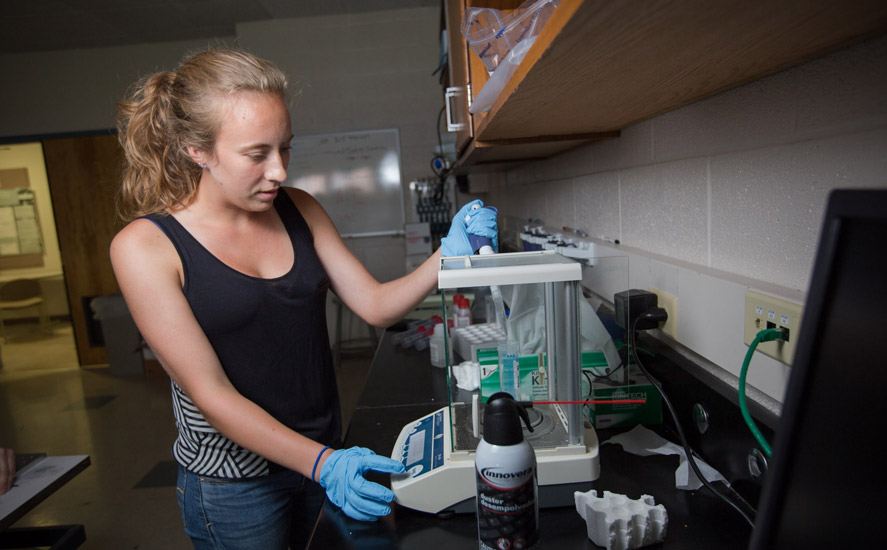 Research with faculty is a hallmark of the Gettysburg College Physics Department. Students from first years to seniors participate in cutting-edge research in a variety of different fields.
Research with faculty is a hallmark of the Gettysburg College Physics Department. Students from first years to seniors participate in cutting-edge research in a variety of different fields.
Research opportunities include summer research on and off campus, independent and collaborative research with faculty, and special projects that may incorporate work in the Observatory and Hatter Planetarium.
Fellowships to support Gettysburg students in summer research in a STEM discipline are available by competitive application to the Cross-Disciplinary Science Institute.
Summer Research 2015
Research Mentor: Dr. Timothy Good
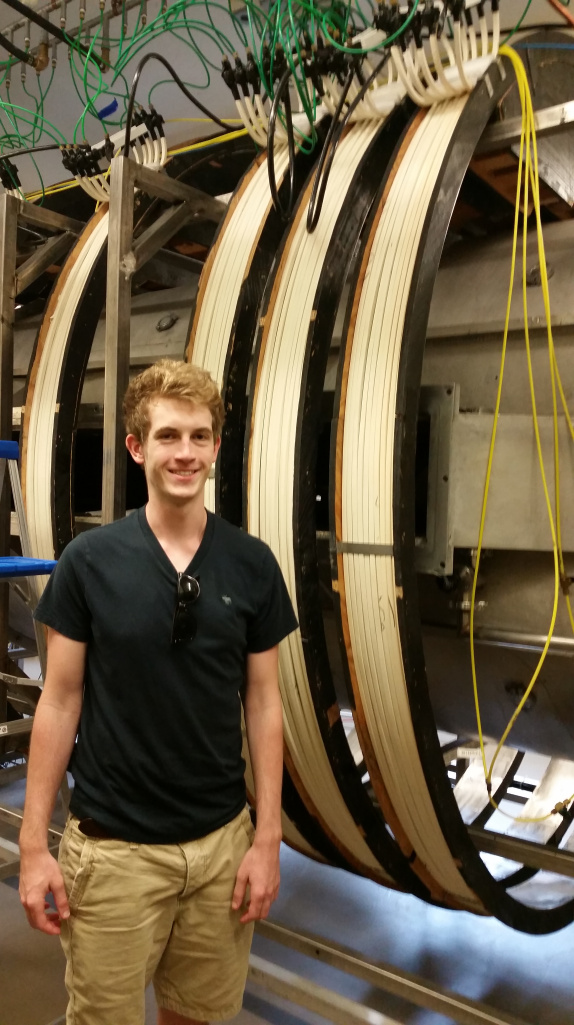 Gordon McCann ’17 and Avery German ’17 assisted Dr. Good in making several upgrades to the Pickets Charged Plasma Device and accompanying laser spectroscopy diagnostic system. The overarching goal of the plasma research is to study the ion respond to ion acoustic waves, and to investigate the ion beam formation in double layer potential structures created in PCPD. They visited the plasma labs of West Virginia University in order to participate in and gain experience from spectroscopic studies of argon plasma exhibiting double layers.
Gordon McCann ’17 and Avery German ’17 assisted Dr. Good in making several upgrades to the Pickets Charged Plasma Device and accompanying laser spectroscopy diagnostic system. The overarching goal of the plasma research is to study the ion respond to ion acoustic waves, and to investigate the ion beam formation in double layer potential structures created in PCPD. They visited the plasma labs of West Virginia University in order to participate in and gain experience from spectroscopic studies of argon plasma exhibiting double layers.
Research Mentor: Dr. Kurt Andresen
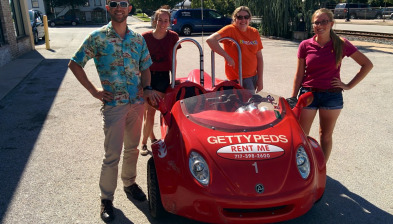 Savannah Miller ’17 majoredin Biochemistry and Molecular Biology and minored in Physics. Her project is a collaboration with Professor Thompson in the chemistry and is focusing on the interaction of ions with polymer coated gold nanoparticles. Gold nanoparticles are exactly what they sound like, gold particles with diameters on the nanoscale (10^-9 m). They have unique properties that make them ideal for many biomedical processes such as imaging, drug delivery, other medical therapies.
Savannah Miller ’17 majoredin Biochemistry and Molecular Biology and minored in Physics. Her project is a collaboration with Professor Thompson in the chemistry and is focusing on the interaction of ions with polymer coated gold nanoparticles. Gold nanoparticles are exactly what they sound like, gold particles with diameters on the nanoscale (10^-9 m). They have unique properties that make them ideal for many biomedical processes such as imaging, drug delivery, other medical therapies.
Sarah Hansen ’17 majored in Physics and minored in Math and Chemistry. Her favorite aspect about biophysical research is being able to combine topics across disciplines in order to explain biological systems. Her project focuses on the competitive binding of hexamminecobalt(III) and magnesium to DNA as the concentration of magnesium increases and DNA-DNA spacing decreases. Hexamminecobalt(III) is trivalent, whereas magnesium ions are divalent, and it has been shown experimentally that trivalent ions are necessary to condense DNA. She was able to use Inductively Coupled Plasma – Atomic Emission Spectra to determine the amount of cobalt, magnesium, and phosphorus in her differing concentration and spacing samples, and determine the charge neutralized by cobalt and magnesium in each one. Sarah found that as the magnesium concentration increased, more charge was neutralized by DNA, and as the DNA spacing decreased, more charge was neutralized by hexamminecobalt(III). Both of these results seem probable given the properties of the system.
Research Mentor: Dr. James Puckett
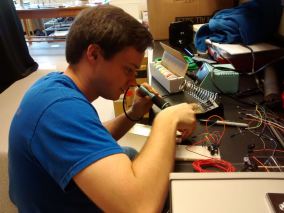 Sam VanFossen ’18 majored in Physics and minored in Music. His research focuses on granular materials, and how physics can help us understand and ultimately predict earthquakes and avalanches. Some everyday examples of these materials are sand and salt. What makes granular materials so complex is how they can transition from a solid to a liquid (think salt pouring from the shaker). Sam's research consists of analyzing how granular materials act under shear strain and building an apparatus to conduct this analysis in a controlled environment. He will be focusing on what happens at the particle scale and relating that back to behavior of the system.
Sam VanFossen ’18 majored in Physics and minored in Music. His research focuses on granular materials, and how physics can help us understand and ultimately predict earthquakes and avalanches. Some everyday examples of these materials are sand and salt. What makes granular materials so complex is how they can transition from a solid to a liquid (think salt pouring from the shaker). Sam's research consists of analyzing how granular materials act under shear strain and building an apparatus to conduct this analysis in a controlled environment. He will be focusing on what happens at the particle scale and relating that back to behavior of the system.
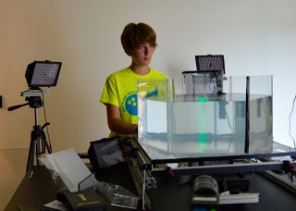 Julia Giannini ’18 researched collective animal behavior. Many different groups of organisms exhibit collective behavior, from the cells in your body, flocks of birds, to people living in cities, we can ask many of the same questions about their organization and behavior. How and why do motion patterns in collective systems arise? How do individuals in a group communicate? Can we mathematically model systems based on the individual parts or the global properties? Would such models be applicable to a wide range of systems (or species)? Could we then use those models to predict the behavior of groups of animals? In order to start to investigate some of these questions, we are studying cohesion in swarms of young Artemia. Using high-speed cameras and stereo-imaging techniques, we can obtain quantitative spacial data for each individual in a swarm.
Julia Giannini ’18 researched collective animal behavior. Many different groups of organisms exhibit collective behavior, from the cells in your body, flocks of birds, to people living in cities, we can ask many of the same questions about their organization and behavior. How and why do motion patterns in collective systems arise? How do individuals in a group communicate? Can we mathematically model systems based on the individual parts or the global properties? Would such models be applicable to a wide range of systems (or species)? Could we then use those models to predict the behavior of groups of animals? In order to start to investigate some of these questions, we are studying cohesion in swarms of young Artemia. Using high-speed cameras and stereo-imaging techniques, we can obtain quantitative spacial data for each individual in a swarm.
Research Mentor Dr. Jackie Milingo
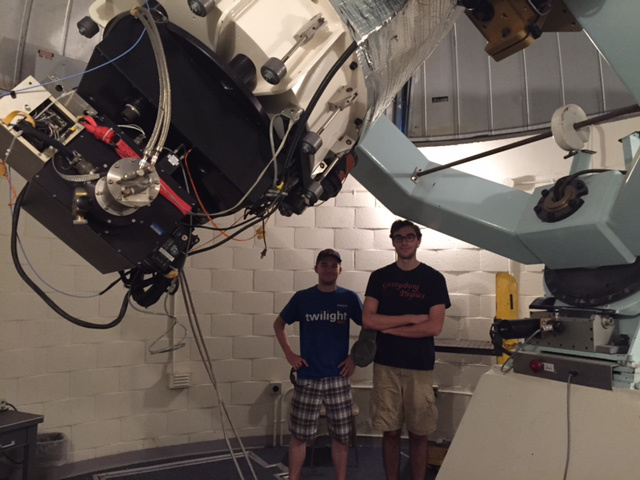 Dylan Mosquera ’17 and Kyle Labowski ’16) researched magnetic activity by observing the stellar cycles of other stars similar to ours, particularly of known spotted stars in open cluster NGC 6811.
Dylan Mosquera ’17 and Kyle Labowski ’16) researched magnetic activity by observing the stellar cycles of other stars similar to ours, particularly of known spotted stars in open cluster NGC 6811.
Research Mentor: Dr. Ryan Johnson
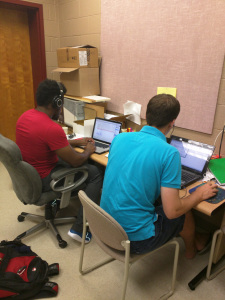 Andre Hinds ’16, and Paul Lessard ’16 worked toward the goals of creating viable statistics to analyze galactic clustering, and of identify merging cluster systems in astronomical surveys, such as the Sloan Digital Sky Survey (SDSS). The long-term application of this project is to constrain the model for gravitational interactions on huge scales. We know, for example, how a ball will interact with the Earth if it is thrown off a cliff with a given speed, but the model that governs that interaction breaks down when applied to extremely large scales, such as those of merging galaxy clusters.
Andre Hinds ’16, and Paul Lessard ’16 worked toward the goals of creating viable statistics to analyze galactic clustering, and of identify merging cluster systems in astronomical surveys, such as the Sloan Digital Sky Survey (SDSS). The long-term application of this project is to constrain the model for gravitational interactions on huge scales. We know, for example, how a ball will interact with the Earth if it is thrown off a cliff with a given speed, but the model that governs that interaction breaks down when applied to extremely large scales, such as those of merging galaxy clusters.
View all faculty publications